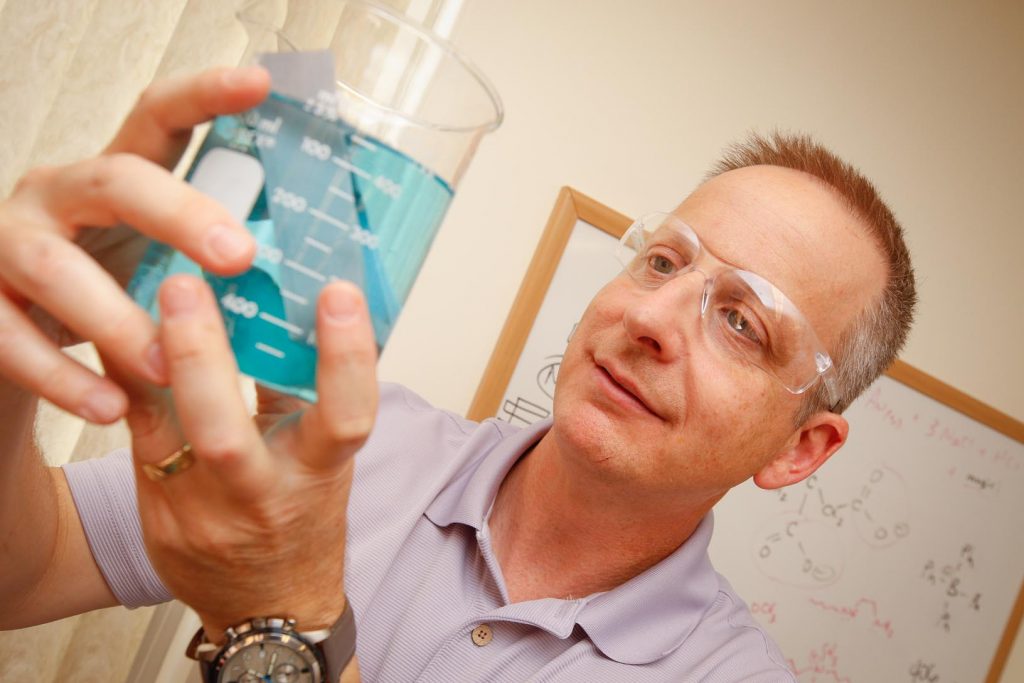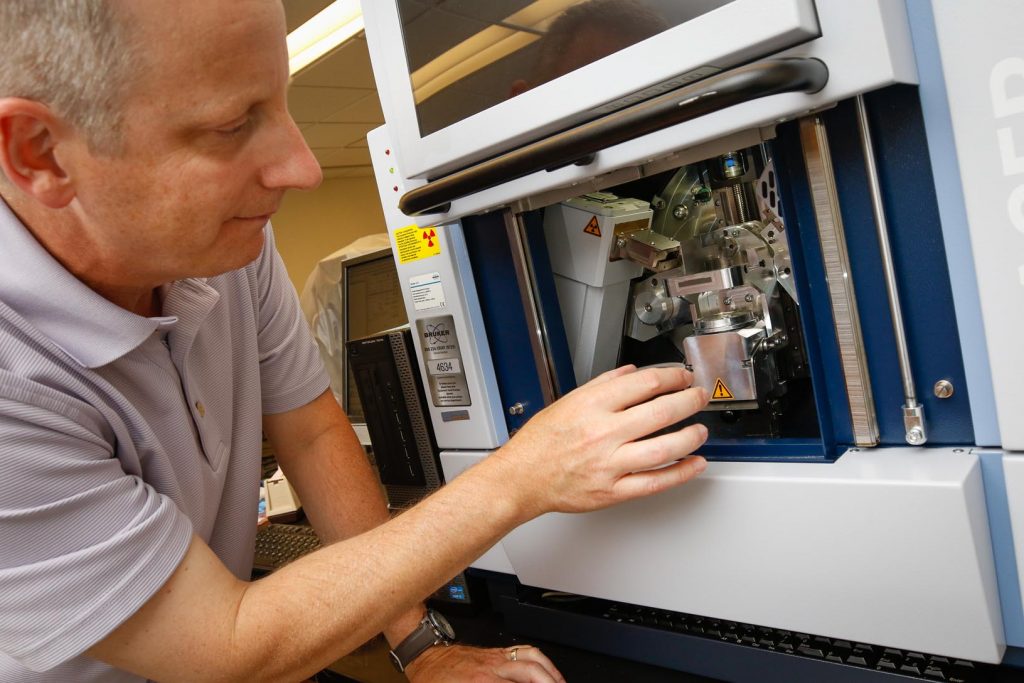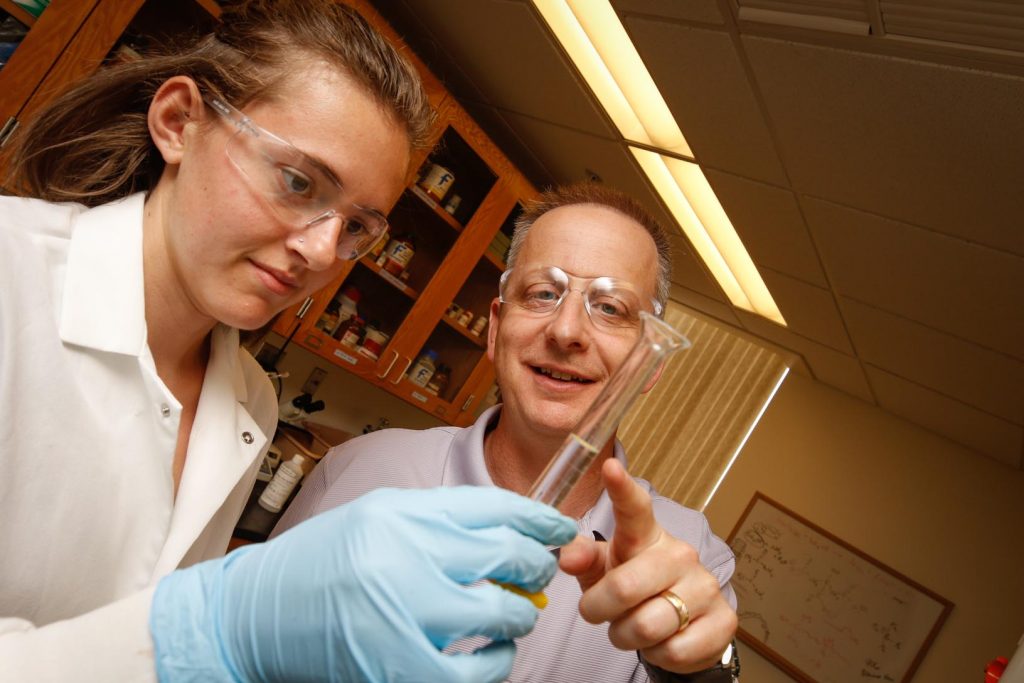 By JAN TREFFER THOMPSON
By JAN TREFFER THOMPSON
UNK Communications
Inside a University of Nebraska at Kearney laboratory, two chemical elements have just become tungsten selenide. Argon that surrounded the reaction has just been purged from the container. It’s time for a heat treatment.
Later, scientists will check the compound’s composition in a Raman spectrometer and use an x-ray diffractometer to test its crystalline structure. If all the crystals are oriented in the same direction, the compound’s electrons could efficiently convert light into electricity.
In the next room, a new dryer is being tested that uses heated carbon dioxide to clean the pores of low-density solids called aerogels.
While the work is part of significant chemistry research, what’s truly unusual are the six scientists who staff this lab. These aren’t doctoral candidates, or even graduate students. They’re undergraduates, doing professional research that will yield career-building conference presentations, publications, or even patents.
Students participate in 99 percent of the research done in UNK’s chemistry department, said Professor of Chemistry Christopher Exstrom, which is unusual at a school without a graduate chemistry program.
What the chemistry undergraduates are able to do, and the advanced equipment they’re able to work with, has come to UNK through Exstrom’s research and related grants; the greatest investment can be credited to his two decades of research on solar cell films.
Since coming to UNK in 1996, Exstrom has published 25 journal articles and received .79 million in grants. He has applied for seven patents, receiving four so far. He and UNK Chemistry Department Chair Scott Darveau began analyzing solar cell films in 2002; the research has yielded around 20 of his journal publications and three of his patent applications.
Exstrom’s work earned him the university’s Leland Holdt/Security Mutual Life Insurance Company Distinguished Faculty Award in 2010, and the Ron & Carol Cope Professorship in 2016. He was also named Undergraduate Research Faculty Mentor of the Year for natural science and received UNK’s Pratt-Heins Award for Excellence in Research and Scholarship in 2006.
But Exstrom said the greatest effect of his projects has been on the department and its students.
“Thanks to our grants and collaborations, we’ve been able to acquire equipment that you rarely see in chemistry departments that don’t have graduate programs. A nice feature about that is we also work these techniques into many of the upper level classes we teach. So when I teach materials chemistry, we take some field trips to the lab and students get some hands-on experience with these techniques,” he said.
Bringing students into the research process wasn’t always an accepted practice. When Exstrom was hired, he said, “there was still a lot of faculty division campus wide about how much research one should be doing, or even if faculty should be doing research. At the time, there was a big camp that thought we should be just teaching our classes – if we didn’t spend all our time teaching our classes, then we’d end up like University of Nebraska-Lincoln, where research is the emphasis.”
In fact, each faculty office in the department used to have a lab bench, “with the idea that if faculty were going to do research they could just do it right there in their office.”
But Exstrom had been trained differently. At Illinois Wesleyan University, where he received his bachelor’s degree, he’d participated in the school’s first student research event. He’d been hired at UNK by James Roark, who encouraged not only faculty research, but student involvement as well.
“Scott (Darveau) and I, we’re the two remaining faculty of a group of five who were hired within two years of each other. And the plan from the get-go was for us to start an undergraduate research program. At the time, we wanted to catch up to what the private schools were doing,” Exstrom said.
“A lot of faculty brought in during the ‘90s had a lot of private school experience, and at the time the private schools were leading the way in incorporating research into the education. In chemistry, the goal with our hirings was to get this started.”
As chair of the department from 2000-06, Exstrom helped spread that research mentality. He said he took the research apprentice program idea from UNK’s honors program, advertising to all freshman and sophomore chemistry majors. The department has eight to 15 apprentices each year, taking on as many as faculty feel they can effectively mentor.
He was also able to help change the building itself.
While the chemistry department had been converting teaching space into research laboratories throughout the 1990s, by the next decade a new layout was needed. As department chair, Exstrom and then-biology department Chair Charlie Bicak moved faculty offices. They put biochemists and molecular biologists together, since those specialties share equipment and interests. Dedicated undergraduate research laboratories were created as part of renovations in 2004 and 2009.
Exstrom and Darveau have run one of the research groups since they began working with solar cells.
Before 1997, Exstrom’s research had focused on vapochromic chemicals, which change color in the presence of certain vapors. The work addressed concerns about buried hazardous waste, which sometimes leaches into soil when the barrels in which it’s housed corrode. Toxic vapors can then make their way into the atmosphere, and companies were interested in developing monitors that could sense the presence of those vapors.
“The grand plan was to make a device that they called an electronic nose,” he said.
While the project yielded five journal articles and four patents, that work dissipated when UNL electrical engineers Rod Soukup and Natale Ianno approached the UNK administration. They had developed a new way of making thin films to coat solar cells, and they were looking for chemists who could analyze those films.
At that time, Exstrom said, “(Scientists) were waist-deep in the second generation photovoltaic solar cell research.” The first generation had been silicon-based materials, developed in the 1970s and applied since the 1980s in products such as solar-powered irrigation pumps.
“There are some problems with silicon. Just as silicon can produce electricity from sunlight, it degrades in sunlight. Then too, you had to achieve a certain thickness of the silicon that limited its potential applications. At the time, the military was interested in making foldable solar cell panels to put on tents or backpacks or whatever,” Exstrom explained. “So we needed thinner materials and materials that were just naturally more efficient.”
That’s what the Lincoln engineers had produced.
UNK students and faculty experimented with processes to make solar cell films, then analyzed the films for composition, phase and purity. The film then went to the UNL engineers, who put it on solar cells.
The project was initially funded by a grant from the Nebraska Research Initiative, a University of Nebraska program. It was the first multi-campus NRI grant, Exstrom said, that represented a 50/50 partnership between Kearney and Lincoln faculty.
Early developments led to funding from U.S. Department of Energy in 2006-11. Currently, the work is funded by the University of Nebraska Foundation.
One result of the project has been more laboratory equipment for UNK. One of the first major additions was a Raman spectrometer, which uses a laser to vibrate the crystal structure of samples. A graph of the frequencies at which the crystals vibrate lets scientists know exactly what’s in their samples.
Across the room is an electron microscope – a low voltage model, Exstrom explains, small enough to sit on a counter and significantly less expensive than graduate students would use at research universities, but far more than undergraduates typically get to work with. In an adjacent room is the x-ray diffractometer, which bombards samples with x-rays, measures and graphs the angles at which the rays are diffracted.
While the group’s solar cell research is focused on tungsten and selenium compounds now, scientists have worked with a variety of materials over the years. Exstrom said they’ve done the most work with mixtures of copper, indium, gallium and selenide (CIGS).
CIGS research yielded Exstrom’s most cited article related to solar cell films, published in 2010. In it, he reports the development of an open air process for creating the material. The finding was significant, he explained, because most reactions have to occur in containers filled with argon or nitrogen. CIGS compounds are typically made using common solvents, which must be heated far beyond their boiling points.
“So (scientists) would have to use these pressure chambers, and that’s inconvenient – you can’t check on the reaction, you have to run it and see what you get,” he said.
Exstrom’s research group decided to use a solvent that boiled at a much higher temperature. It was heated to an even higher temperature than scientists usually used in making CIGS, but because the solvent could go to that temperature, they didn’t need a pressure chamber.
“It’s much simpler to be able to prepare a pot and sit it on the lab bench,” Exstrom said. They were the first group in the world to use such a method in preparing CIGS nanocrystals.
Three undergraduates are among the authors of the open-air reaction article; students are also typically named on patent applications that have resulted from research, which Exstrom said is unusual because the standard for participation is high. “You really have to prove they contributed to the originality of the idea,” he said, but with the level of student involvement at UNK that routinely happens.
CIGS is a second-generation solar cell material that’s now commonly used at large solar farms; it gives the greatest efficiency from sunlight to electricity, and can be made into very thin films. But these compounds also have disadvantages, including the shortages of elements such as indium.
Scientists have moved on to a third generation, and so has UNK.
The first third-generation material Exstrom’s group studied was iron pyrite, which is very stable except for a few molecules’ thickness at the particle surfaces. The phases that form there are not semiconductors, so Exstrom said the group has focused on another Earth-abundant semiconductor instead, tungsten selenide.
“It’s fairly easy to produce or process from ores, and the interesting thing about it is that it forms a layered material. It just naturally forms these layered sheets at a molecular level, and it turns out that helps conduction. So if you make a high enough quality sample, it’s just naturally designed to conduct electricity well,” Exstrom said.
The naturally formed sheets can be just one formula unit thick – one layer of tungsten and two layers of selenium – making it useful for molecular electronics.
“We actually need something thicker for the solar cell applications. So to make a thicker film and keep all these sheets parallel to one another is one of the challenges,” Exstrom said. Another challenge is the temperature required to process it, around 1,000 degrees Fahrenheit.
Exstrom’s group has made progress on that second hurdle, developing a low-temperature process for creating tungsten selenide that’s outlined in a 2016 journal article. Though the two-step process still requires heating to 550 degrees, it’s a much lower temperature than traditional methods.
AEROGEL PROJECT
Since 2014, Exstrom has made time away from solar cell research to collaborate with engineers Dennis Alexander and George Gogos of UNL. The project has been financed by a grant from the National Aeuronautics and Space Administration.
The collaboration began when the Lincoln engineers developed a femtosecond laser treatment for metals.
“They can make all these contoured micro and nanofeatures in a controlled fashion, and it has different effects on heat transfer in the material,” Exstrom said. NASA’s application goal is for equipment such as satellite components.
“You take a metal and treat it with a pulsed laser, carefully time the pulses and the power, and they can create these micro and nanostructural contours and features. They can make pyramids, mounds, spheres; they can make mounds that rise above the surface, mounds that are in holes below the surface. But what they didn’t have a good grasp on was the chemical analysis of the surface environment on these. Because it’s very possible to oxidize it and create these different compounds on the surface.”
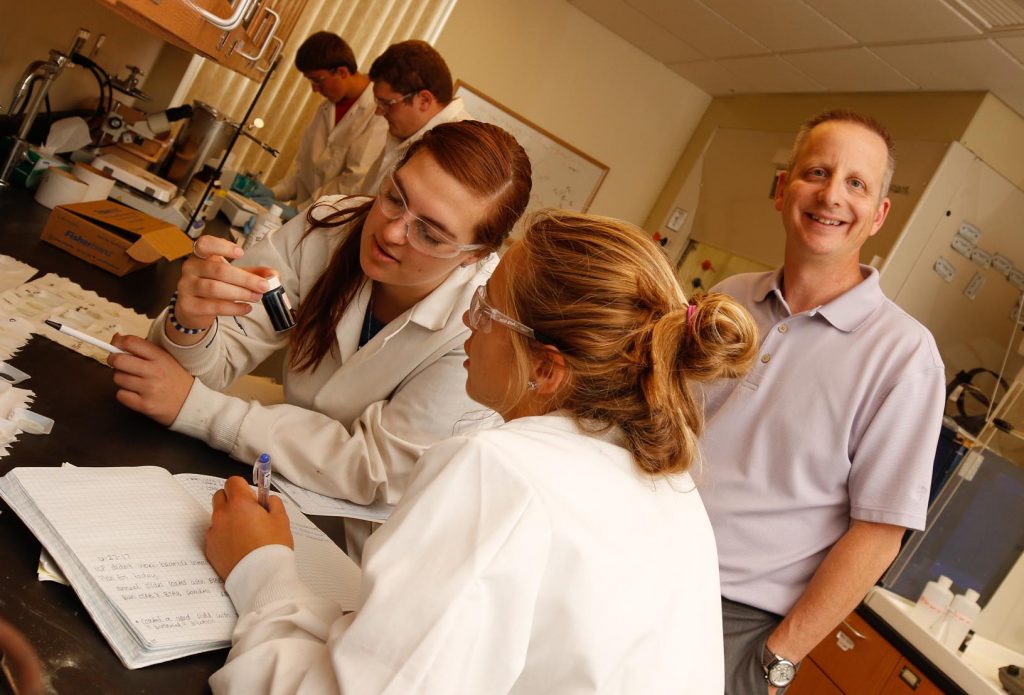 UNK’s role was first to simply analyze metal samples that had been given this laser treatment, checking the samples’ composition and crystal structures. As the project developed, though, the scientists discovered that the treated surfaces were very porous. The UNK group began trying to imbed aerogels into the pores. Solid materials that have extremely low density, aerogels make good insulation.
UNK’s role was first to simply analyze metal samples that had been given this laser treatment, checking the samples’ composition and crystal structures. As the project developed, though, the scientists discovered that the treated surfaces were very porous. The UNK group began trying to imbed aerogels into the pores. Solid materials that have extremely low density, aerogels make good insulation.
“There are some direct applications if treating the metal surfaces on satellite components makes a difference in the thermal conductivity of the electronics, or can improve their function,” Exstrom said. “Faster heating and cooling can help the satellite adapt to microenvironments it passes through in orbit.”
The research group had to learn how to make aerogels, then find ways to embed them onto the metals. While no publications have come from the project yet, Exstrom said he’s excited about the originality of their work.
“We can’t find any other examples of this phenomena where you’ve been able to take another material and actually penetrate it into the surface of these treated samples,” he said.
The aerogel project is an example of the many opportunities now coming to the department because of the group’s previous solar cell work.
“With our reputation we’ve gained from our solar cell work, and people know we’re experienced with nanoparticles, we’ve had collaboration requests on some very different projects, like the aerogel project,” Exstrom said. What pleases him most about those requests is the experience they offer students for real, relevant research.
All six students working in the laboratory will end their summer by developing poster presentations, which they’ll take to regional or national conferences in the fall. That point is usually when students realize what they’ve accomplished.
“It’s when they put their posters together that they see all the pieces of the puzzle at one time, instead of just being so focused on trying to remember how to run a Raman spectrum,” Exstrom said.
That moment represents the balance he wants to strike – the point where teaching and research connect.
“What I envision is that there is a middle ground that can combine the best aspects of both teaching and research, and bring them together. That’s what I’ve tried to stand for during my career. The more I can integrate with teaching research and service, I think those are the things that have had the most traction.”
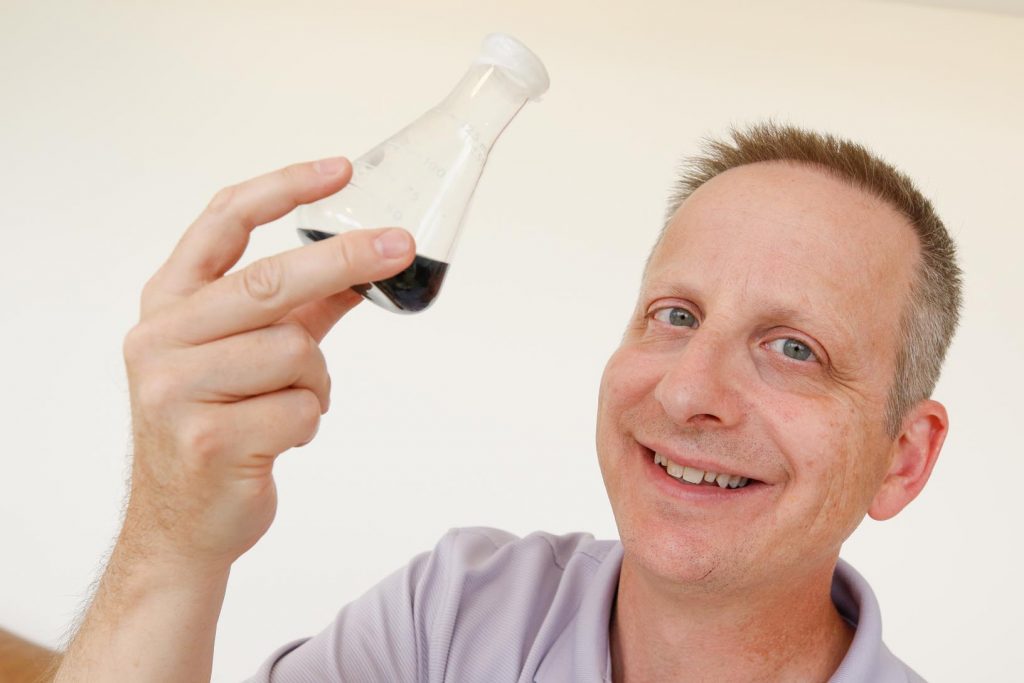 CHRISTOPHER EXSTROM
CHRISTOPHER EXSTROM
Title: Ron and Carol Cope Professor, Chemistry
College: Natural and Social Sciences
Education: Ph.D., Chemistry (Inorganic/Analytical/Physical), University of Minnesota, 1995; Bachelor of Arts, Chemistry, Illinois Wesleyan University, 1990.
Years at UNK: 21
Career: Visiting Assistant Professor of Chemistry, Kenyon College, 1995-96; Assistant Professor of Chemistry, University of Nebraska at Kearney, 1996-2000; Associate Professor of Chemistry, UNK, 2000-06; Chair, UNK Dept. of Chemistry, 2000-06; Professor of Chemistry, UNK, 2006-16; Ron & Carol Cope Professor of Chemistry, 2016-present; Director of Science/Math Education, UNK Master of Science in Education program, 2012-present.
Family: Wife, Suzanne, office associate UNK Social Work Dept.; Sons: Geoff, 17, and Robbie, 14.
Hobbies/Interests: Golf, bowling, wine tasting, science fiction, film
Honors/Awards: Ron & Carol Cope Professorship, 2016; Leland Holdt/Security Mutual Life Insurance Co. Distinguished Faculty Award, 2010; Pratt-Heins Award for Excellence in Research and Scholarship, 2006; Undergraduate Research Faculty Mentor of the Year, Natural Sciences, 2006.
Areas of research/specialization: Semiconductor nanoparticle synthesis and characterization for solar cell and sensor applications, Material film characterization for various electronics and structural applications.
Courses taught: Undergrad courses in introductory, general, inorganic, analytical, environmental and materials chemistry. Graduate courses in inorganic and environmental chemistry, and chemical management and safety.
Recent Published Articles:
– “A Low-temperature Fabrication Method for WSe2 Films Grown from Nanocrystalline Precursors,” MRS Advances, 2016.
– “Properties of CuIn1-xGaxSe2 Films Prepared by the Rapid Thermal Annealing of Spray-deposited CuIn1-xGaxS2 and Se,” Materials Research Society Symposium Proceedings, 2011.
– “Thermoelectric Properties of p-type CuInSe2 Chalcopyrites Enhanced by Introduction of Manganese,” Physical Review B, 2011.
– “Air Stable, Photosensitive, Phase Pure Iron Pyrite Nanocrystal Thin Films for Photovoltaic Application,” Nano Letters, 2011.
– “A Non-vacuum Process for Preparing Nanocrystalline CuIn1-xGaxSe2 Materials Involving an Open-air Solvothermal Reaction,” Solar Energy Materials and Solar Cells, 2010.
-30-
